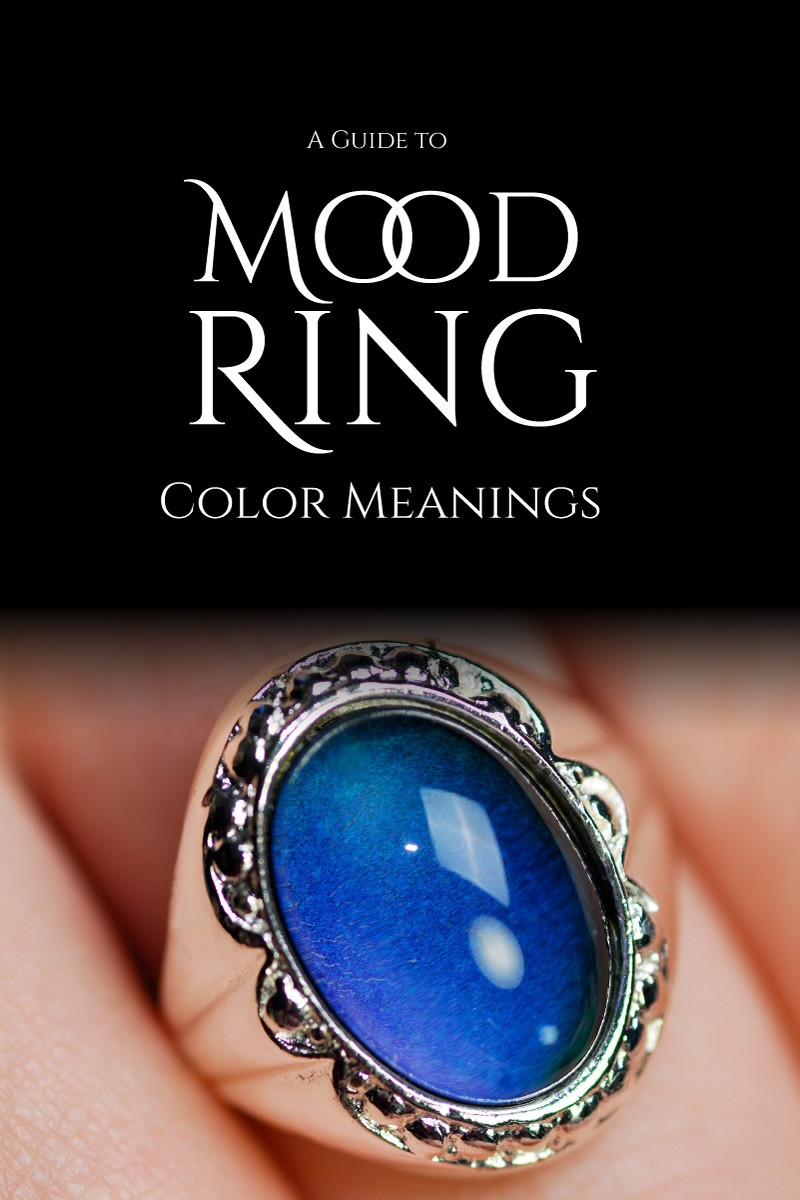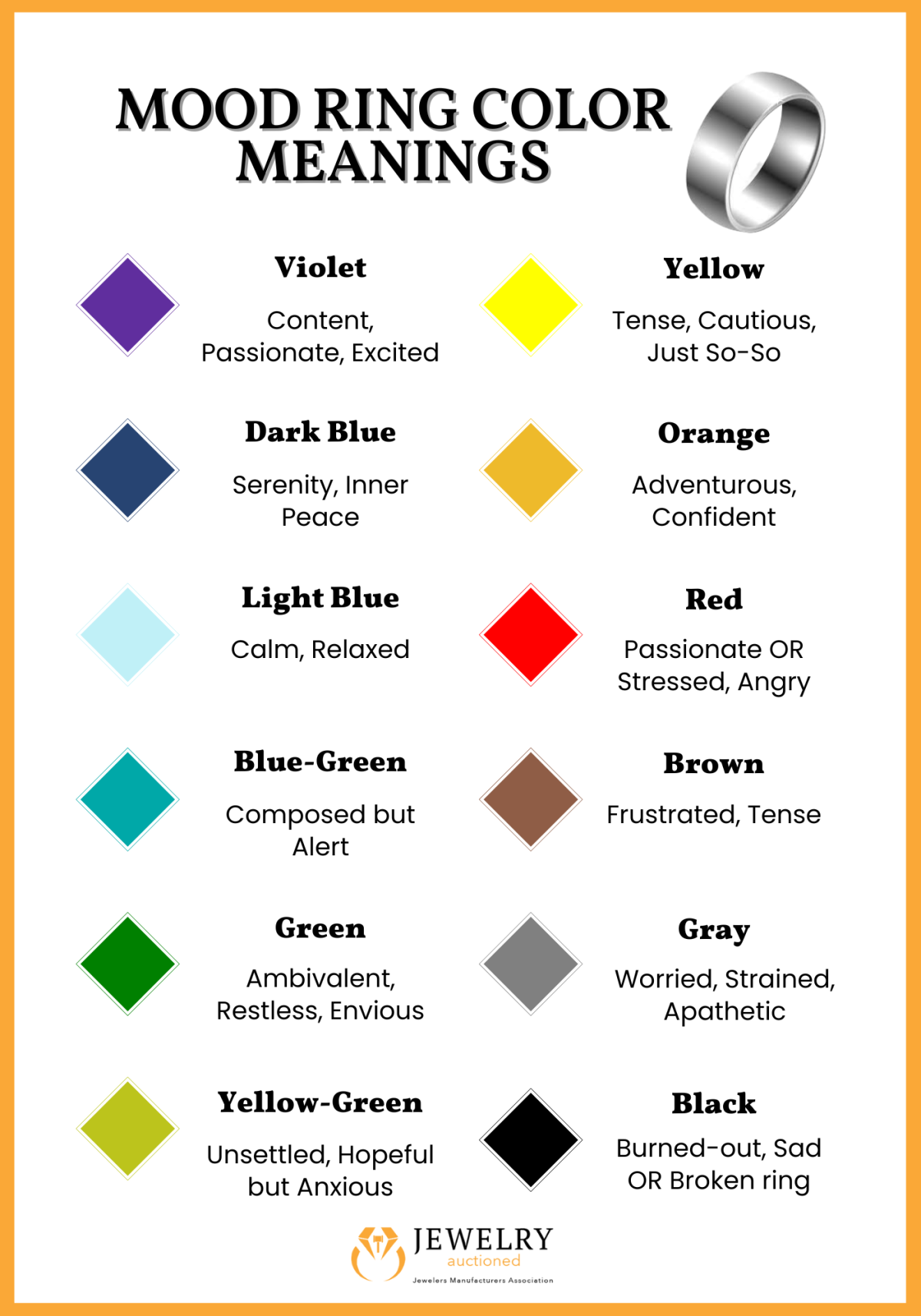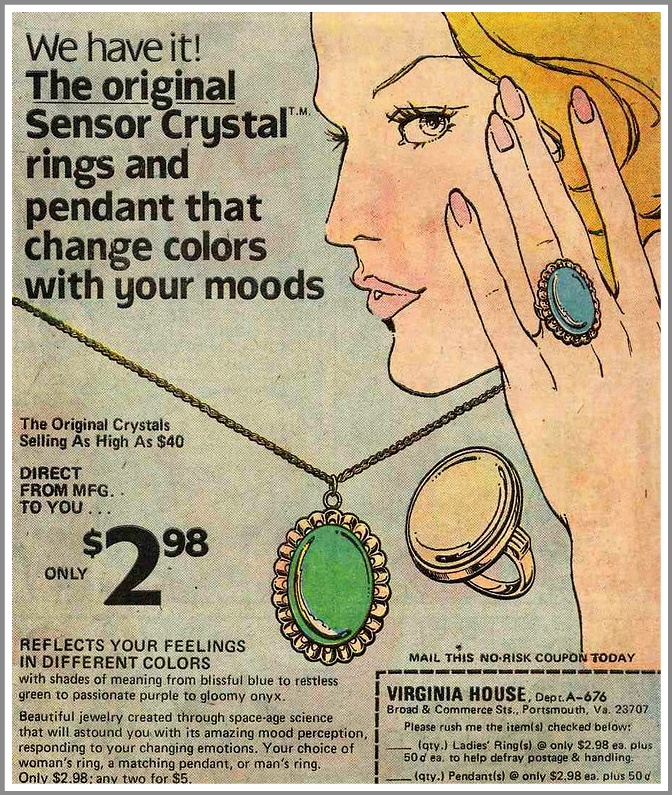
完整的心情戒指指南:颜色含义、图表和历史
 心情戒指是一种流行的温度感应变色戒指,佩戴时会根据您当前的心情改变颜色。这种戒指在 20 世纪 70 年代发明,反映了当时的文化更加注重精神性和自我反省,尤其是在美国。
心情戒指是一种流行的温度感应变色戒指,佩戴时会根据您当前的心情改变颜色。这种戒指在 20 世纪 70 年代发明,反映了当时的文化更加注重精神性和自我反省,尤其是在美国。
变色情绪戒指问世已有近 50 年,在 20 世纪 70 年代和 90 年代推出后,人气飙升。其他名称包括“多色情绪戒指”和“Sensor Crystal™ 戒指”。
但情绪戒指还流行吗?是的,你仍然可以找到出售的情绪戒指。它们可能不像以前那么受人关注或广受欢迎,但多年来情绪戒指一直是许多年轻女孩的必备品。
今天,我们将讨论情绪戒指为何如此受欢迎、其工作原理背后的科学原理以及每种情绪戒指颜色的含义。

情绪戒指如何发挥作用?
简而言之,情绪戒指是温度变化的指示器。里面的“石头”实际上是一种热致液晶凝胶,因此当温度变化时它会改变颜色。从技术上讲,温度变化会导致液晶移动,从而改变它们反射的颜色。
每个情绪戒指制造商使用的配方、材料和技术略有不同。大多数情况下,中性基色会调整为与标准基线体温相对应。
大多数情绪戒指都含有源自有机聚合物的液晶。然后将混合物包裹在玻璃或石英中。最简单的情绪戒指有一个金属环底座,顶部粘有热致变色液晶条,并像凸圆形宝石一样包裹在玻璃或塑料保护层中。
您了解了科学方面的内容,现在该了解一下神奇方面的内容了。心情戒指上的颜色代表什么?
心情戒指颜色含义列表
最初的情绪戒指有 6 到 7 种颜色,从最不积极到最积极的情绪列出:黑色、灰色、黄色、绿色、蓝色和紫色,有时还有第七种颜色,如红棕色或其他蓝色。
当然,科学总是在进步。如今,情绪戒指有各种颜色和相关情绪。下面,我们将介绍情绪戒指中的颜色代表什么,并附上一张图表,方便参考。
紫色或紫蓝色
自情绪戒指问世以来,紫色或紫蓝色一直被认为是最佳颜色,反映出满足、激情和兴奋的情绪状态。20世纪 70 年代的一则多色情绪戒指广告称,“最令人向往的紫蓝色调。”
紫罗兰色或紫色情绪戒指颜色含义的其他解释是您感觉多愁善感、亲密或坠入爱河。
深蓝
深蓝色情绪戒指的颜色含义是深沉的平静和完全的宁静。当您看到自己的情绪戒指呈深蓝色时,这表明您内心真正平静,正念十足。
浅蓝色
和深蓝色一样,浅蓝色的情绪戒指颜色表示您感觉平静和放松,但可能不像深蓝色那样深沉。大多数情绪戒指都有蓝色基线颜色,显示您的身体处于标准温度。
蓝绿
情绪戒指的颜色为蓝绿色,与完全平静不同,它表示您相当放松,但也十分警觉。这种警觉可能是由于潜意识中的焦虑所致,而这些焦虑并非您最关心的问题。毕竟,情绪戒指最初的宣传就是揭示您最真实、隐藏或潜意识的情绪。
蓝绿色情绪戒指也可能只是表示您很平静,但也有些活跃。也许您在放松的同时进行一些有趣的互联网研究,这让您很感兴趣。
绿色的
当你的情绪戒指呈绿色时,这可能表示矛盾或不安。也许你对即将发生的情况感到不确定。当然,你也可能感到嫉妒,尽管这可能不会占据你的生活。
我们应该注意到,许多情绪环都有绿色基线,而不是蓝色,所以绿色表示中性平静。
黄绿色
黄绿色的情绪戒指表示您情绪复杂,心神不宁。当您想起暗恋对象,感到充满希望却又焦虑时,可能会出现这种颜色。
你可能比平时更敏感,更容易烦躁或沮丧。但总体而言,你还是比较镇定的。
黄色的
黄色是我们开始了解情绪戒指颜色含义的地方,尽管并不总是很好。黄色情绪戒指颜色表示您感到紧张和谨慎。
你可能脑子里有很多想法,但你无法确定其中的韵律或理由。从好的方面来说,你可能感觉一般。从坏的方面来说,你可能会有一种不祥的预感。
尽管如此,有些人将黄色情绪戒指的颜色解读为富有想象力、观察力和创造力。
琥珀色或橙色
橙色或琥珀色的情绪戒指颜色表明您渴望刺激和冒险。这种情绪戒指颜色代表着新的开始,以及自信和感情。
如果您外出与爱人做一些冒险的事情,感觉自己可爱又自信,那么琥珀色的心情戒指就是您的不二之选。
红色的
对于红色情绪戒指颜色含义的解读有两种。
一方面,红色情绪戒指的颜色可以反映激情、兴奋和兴奋,就像约会之夜穿的性感红裙一样。另一方面,红色情绪戒指可能表示您感觉压力很大、惊慌失措或愤怒。
一般来说,前一种解释适用于深红色,而后一种解释适用于鲜红色。
棕色的
如果您的情绪环是棕色的,这表示您感到沮丧、不安和紧张。您可能对某事感到恐惧或恼火,无法将其从脑海中抹去。
棕色的情绪戒指颜色通常出现在紧张的预期或烦恼的时候。
灰色的
与棕色类似,灰色的情绪戒指表示您感到忧虑或紧张。不过,灰色表示更多的幻灭感,带有冷漠、悲观和冷漠的感觉。
黑色的
黑色情绪戒指颜色的含义可以说是最糟糕的,表示精疲力竭、压力和压抑。有些人将黑色情绪戒指颜色解释为神秘或强烈,但大多数人将黑色解释为情绪低落。黑色通常出现在最冷的温度下。
现在,黑色情绪戒指也可能出现故障。由于温度过高或潮湿而损坏的情绪戒指会变黑。
以下是一份方便的情绪戒指颜色含义图表,可供快速参考:

心情戒指的历史
心情戒指始于 20 世纪 70 年代的一场热潮。大多数资料都认为,心情戒指的发明者是两位纽约人:约书亚·雷诺兹和马里斯·安巴特斯。
雷诺兹 30 多岁时曾是华尔街的一名营销主管,但后来对生物反馈产生了兴趣,据报道,这让他萌生了制作情绪戒指的想法。
然而,其他人则将这一发明归功于加利福尼亚珠宝商马文·沃尼克 (Marvin Wernick) ,据称他在看到医生用热敏胶带测量儿童体温后产生了这一想法。
无论如何,情绪戒指于 1975 年 8 月上市,并在百货公司 Bonwit Teller 的帮助下销量飙升,Bonwit Teller 将其作为“真相戒指”进行营销。
 上图:20 世纪 70 年代复古情绪戒指广告
上图:20 世纪 70 年代复古情绪戒指广告
头三个月,戒指销量达 4000 万枚,曾出现在芭芭拉·史翠珊的手上,甚至还成为穆罕默德·阿里一首诗的主题。第一年,雷诺兹从情绪戒指销售中赚取了至少 2000 万美元。
尽管当时大多数情绪戒指价格低廉且不耐用,但情绪戒指的流行度却日益提升,促使珠宝商用黄金和纯银等金属打造出更高品质的版本。
情绪戒指的流行反映了 20 世纪 70 年代文化的许多基本方面,尤其是在美国。
美国作家汤姆·沃尔夫将 70 年代称为“自我的十年”(就在情绪戒指推出一年后),描述了许多人的态度转变,从以社区为基础的努力转向专注于更好地了解自我和情绪。
不幸的是,情绪戒指的流行只持续了大约一年左右,也就是到 20 世纪 90 年代。
 上图为 20 世纪 70 年代情绪传感器水晶戒指复古漫画广告
上图为 20 世纪 70 年代情绪传感器水晶戒指复古漫画广告
20 世纪 90 年代的复兴
据《芝加哥论坛报》报道,十五年后的 1991 年,情绪戒指“卷土重来”。复兴始于两名女性发现人们对“复古”情绪戒指感兴趣,并创办了自己的公司。与第一波类似,这两名女性在头三个月就卖出了 10 万枚戒指。
利用这一现象,短命的服装公司 Hypercolor 开始销售变色服装。这股潮流延伸到 2004 年的宠物情绪项圈、2014 年的 LED“情绪毛衣”和各种情绪指甲油。
心情戒指的变更和改进
自最初的情绪戒指发明以来,其成分随着时间的推移不断改进。
最初的情绪戒指一旦有水进入内部的液晶,就会停止工作。现代版本对液晶进行了更好的密封,以防止水分进入内部。
事实上,最初被认可的发明者乔希·雷诺兹 (Josh Reynolds) 与 The Mood Science Company 团队在过去几年中推出了一款全新改进版:2018 Mood Stone。新系列包括原版和新版情绪戒指,所有戒指均为纯银或镀金。
其他公司也已推出蓝牙数字情绪戒指,该戒指可以根据温度以外的更多物理反应来测量和反射颜色。
 图片来源:Moodman001 | Creative Commons 署名-相同方式共享 4.0 国际许可
图片来源:Moodman001 | Creative Commons 署名-相同方式共享 4.0 国际许可
情绪戒指有用吗?
用体温来衡量情绪状态的想法有一定科学依据。你的内分泌系统(主要负责调节激素)可以根据不同的情绪状态调整生理状况(如体温、心率和血流量)。
当你感受到爱或快乐时,你的体温会升高,而当你感受到羞耻或悲伤时,体温会降低。事实上,研究表明,在不同文化中,某些情绪在身体的特定部位会相当一致地被感受到。
要记住的一个因素是温度变化的程度。体温不会发生剧烈变化,因此情绪戒指必须非常精确地感知哪怕是最轻微的温度变化。
尽管如此,温度(以及情绪戒指)并不是你情绪状态的唯一指标。很多生理变化都在起作用。
然而,从心理学的角度来看,情绪戒指有助于调节压力和更好地了解自己的情绪。
2018 年,乔希·雷诺兹 (Josh Reynolds)告诉Stu News Laguna ,他和他的团队(其中包括一名科学和医学总监)进行的研究“表明,与 40 年前相比,戒指的自我意识和压力管理功能对从青少年到婴儿潮一代的人群具有更广泛的吸引力。”
从这个角度来看,情绪戒指可以提醒您当前的情绪状态并提高注意力,最终提高情商和自我意识。
情绪戒指可以持续多久?
自 20 世纪 70 年代以来出现的大多数情绪戒指现在可能都不再起作用,但自那时起,人们已经对其进行了改进,以提高其使用寿命。
情绪戒指至少可以使用两年左右,有些甚至可以使用五年。
情绪戒指功能的最大威胁是潮湿。一滴水接触到液晶就会使戒指永远变黑。避免在淋浴、海边或泳池中佩戴情绪戒指。
可能损坏情绪戒指的其他因素包括长时间直接暴露在高温下。不要将情绪戒指放在炎热的汽车中或存放在阳光直射的地方。
存放情绪戒指的最佳位置是室温区域,远离阳光直射和潮湿。

想要一枚心情戒指吗?
情绪戒指可能在 70 年代和 90 年代达到了鼎盛时期,但它们仍然是一种文化主流,尤其是在年轻女性中。
有些人可能将情绪戒指视为俗气的新奇物品,而另一些人则可能将其用作检查自己情绪的提醒器。还有些人可能欣赏情绪戒指体现 20 世纪 70 年代的重大文化转变的方式。
准备购物?浏览我们的心情戒指系列!
搜索Fashion Encyclopedia




